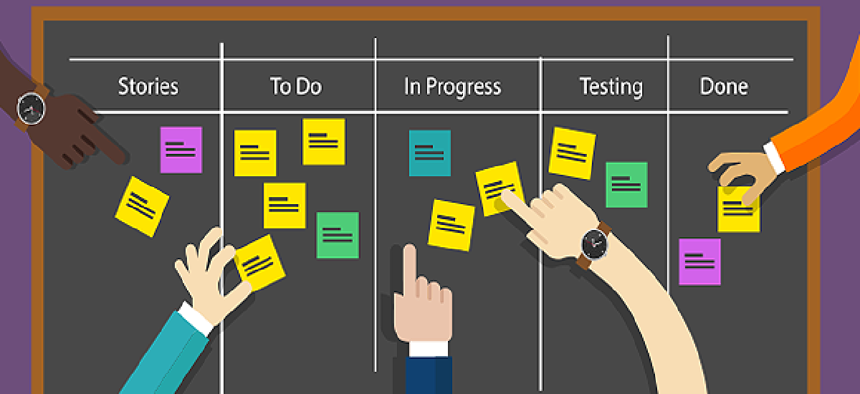Getting started with an agile scrum approach

Momentum, customized team norms, transparency and trust are the foundation of a solid agile scrum practice.
Many government agencies are beginning to follow industry’s lead by adopting agile methodologies -- a cultural and strategic shift that helps teams deliver higher quality functionality to end users more quickly and achieve frequent successes that contribute to business-line missions. Momentum, customized team norms, transparency and trust are the foundation of a solid agile scrum practice.
The scrum team, a mostly self-organizing unit in an ideal world, consists of a product owner, a scrum master and the execution team. The product owner provides the voice of the customer and sets overall objectives, priorities and requirements of the system. The scrum master, or team leader, is actually a servant of the team, helping team members stay focused and working to remove roadblocks that impede progress. The execution team members focus their energy on creativity around the desired features and are not bogged down by processes.
Just get started
Though it may be contrary to established practices, government agency leadership should empower teams and managers to implement agile methods quickly and should not expect perfection immediately. “Just get started” sounds like a catch phrase, but it works. The march toward perfection and low risk in agile comes from reviewing and refining processes, iteration after iteration, through a deliberate retrospective process, not by trying to think of all possible scenarios before the start.
"Fail early and fail fast" isn't just a slogan on a wall. Not being bogged down by fear of failures, or the associated judgment that could arise, builds momentum toward success. Have trust that the retrospective process, where projects are regularly reviewed, will allow teams to course correct.
Baseline metrics are critically important, but their establishment shouldn't impede progress. Start with a few key indicators typical to any agile adoption. These metrics simply need to be good enough to get started. Estimate and use the retrospective process to refine estimations during subsequent iterations.
The cyclical agile rhythm -- the cadence of try, fail or succeed, review, retrospect, repeat -- is critical. It is easy for teams to abandon the rhythm, so scrum masters must help the team stay disciplined. An efficient rhythm that produces results will help maintain project support outside the scrum, within the agency at large.
Evolve team norms
The Agile Manifesto methodology applies to all scrum teams, but to be effective, teams must create their own unique norms, or principles the team agrees to follow, once they’ve transitioned to action. To start, team norms will be sparse, but they get refined and polished over time, based on lessons learned from actual experience within the environment.
The first product or service iteration, or “Sprint 0,” establishes the base team norms and provides the footing to be tuned perfectly to the environment over time. Start with very few but meaningful norms; the handful that do exist must be clear, prescriptive and strictly followed.
As the shepherd who guides new teams, the scrum master maintains a little distance for perspective and helps the team adhere to its norms. As teams mature, each team member becomes responsible for the norms enforcement and, as in a sports team, pressure each other to be good teammates by following the commonly derived and accepted norms.
The team’s norms should be documented, because they could change during retrospectives or post-mortems. Why the norms changed is as important as the fact that they have changed. Documentation will help new team members, customers and managers quickly understand the norms and why they may have changed. There should be no ambiguity around team norms.
Enable and practice transparency
Agile teams flourish in a safe, judgment-free environment where all team members feel as if they are respected and have a responsibility in the process. Team norms can be refined over time only in such an environment, leading to a near-perfect set of rules finely tuned to the specific environment.
Ultimately, federal leadership plays a role in implementing agile methodology by avoiding judgment and instead offering support. Transparency and openness in a successful agile adoption builds trust in all directions.
When teams recognize success built on lessons learned from failures, there is a multiplier effect, which reinforces positive behaviors that move the entire team forward and ensure success. Retrospectives form the foundation of continuous team improvement and can help a team recover from nearly any source of weakness in an environment of transparency and trust.
NEXT STORY: Can learning games replace standardized testing?





